 More circus memorabilia from the 1960’s today, with an emphasis upon anime, plus the American creations of Joe Oriolo and Hal Seeger.
More circus memorabilia from the 1960’s today, with an emphasis upon anime, plus the American creations of Joe Oriolo and Hal Seeger.
 The Birth of Astro Boy (Osamu Tezuka/Mushi Productions, 1/1/63) – The plotline of this origin story of the character (known in Japan as “Mighty Atom”) is a bit of a modern-day twist on Pinocchio, but with an odd maudlin angle that probably was a bit heavy for an average American child audience to comprehend. A young boy is killed – in this adaptation, by a freak accident involving a self-driving car that is supposed to be controlled by signals embedded in the highway. (Quite prophetic, as modern-day driverless taxis and trucks continue to be the subject of experiment – and accidents.) The father, a noted scientist and head of a research institute, is torn by grief, and hatches out of the depths of his despair a plan to devote the entire resources of the institute toward a single project – to build a super robot, in the likeness of his lost son. The other scientists realize he may be going cuckoo, but nevertheless follow his orders, producing Astro Boy. The intelligent robot seems to possess a full range of emotions, learns quickly, and rapidly accepts its place in what it believes is a loving relationship with his new “father”. For a time, Astro and “dad” seem to get along famously. That is, until a few years pass, and the scientist realizes he has overlooked something that to him is important – Astro Boy does not grow to match other children of his age. The scientist is suddenly struck with the artificiality of the situation, and begins to see the folly of his hopes that this robot could ever be a replacement for his lost son. The scientist becomes more and more frustrated with Astro, distancing himself from the robot despite the robot’s unwavering devotion to him, and finally renounces any continued love for the robot whatsoever. Before Astro knows it, he is sold away to the operator of a robot circus – who just happens to be of Italian accent, leading to direct parallels where it is evident he is playing the role of Stromboli in this story. The circus owner’s claim to fame is the staging of battles between his robots, in the manner of epic gladiators of Rome, with each battle intended to be a duel to the finish of one of the combatants. Astro is pitted in his opening bout against a large steel robot at least eight times his size. Among the audience is a spectator who has attended not to marvel at the battle, bit in the hope of breaking it up – another scientist from the institute, with a large oversized nose (known by the unimaginative translation of Professor Elefun). He enters the center ring before the real blows begin, and demands that the owner/ringmaster release the boy from such cruelty. But the circus owner flashes in the scientist’s face a dozen permits under which he operates his shows, pointing out that there is no regulation against pitting robots against each other. The Professor is forced to turn away, amidst the boos of the crowd, at present powerless to stop what will follow. Astro discovers the use of rocket power built into his heels, and flies around the tent, then into the chest of his opponent, knocking him down. The circus owner shouts to Astro to finish him – but Astro has not the will nor the heart to cause any further harm to the large robot.
The Birth of Astro Boy (Osamu Tezuka/Mushi Productions, 1/1/63) – The plotline of this origin story of the character (known in Japan as “Mighty Atom”) is a bit of a modern-day twist on Pinocchio, but with an odd maudlin angle that probably was a bit heavy for an average American child audience to comprehend. A young boy is killed – in this adaptation, by a freak accident involving a self-driving car that is supposed to be controlled by signals embedded in the highway. (Quite prophetic, as modern-day driverless taxis and trucks continue to be the subject of experiment – and accidents.) The father, a noted scientist and head of a research institute, is torn by grief, and hatches out of the depths of his despair a plan to devote the entire resources of the institute toward a single project – to build a super robot, in the likeness of his lost son. The other scientists realize he may be going cuckoo, but nevertheless follow his orders, producing Astro Boy. The intelligent robot seems to possess a full range of emotions, learns quickly, and rapidly accepts its place in what it believes is a loving relationship with his new “father”. For a time, Astro and “dad” seem to get along famously. That is, until a few years pass, and the scientist realizes he has overlooked something that to him is important – Astro Boy does not grow to match other children of his age. The scientist is suddenly struck with the artificiality of the situation, and begins to see the folly of his hopes that this robot could ever be a replacement for his lost son. The scientist becomes more and more frustrated with Astro, distancing himself from the robot despite the robot’s unwavering devotion to him, and finally renounces any continued love for the robot whatsoever. Before Astro knows it, he is sold away to the operator of a robot circus – who just happens to be of Italian accent, leading to direct parallels where it is evident he is playing the role of Stromboli in this story. The circus owner’s claim to fame is the staging of battles between his robots, in the manner of epic gladiators of Rome, with each battle intended to be a duel to the finish of one of the combatants. Astro is pitted in his opening bout against a large steel robot at least eight times his size. Among the audience is a spectator who has attended not to marvel at the battle, bit in the hope of breaking it up – another scientist from the institute, with a large oversized nose (known by the unimaginative translation of Professor Elefun). He enters the center ring before the real blows begin, and demands that the owner/ringmaster release the boy from such cruelty. But the circus owner flashes in the scientist’s face a dozen permits under which he operates his shows, pointing out that there is no regulation against pitting robots against each other. The Professor is forced to turn away, amidst the boos of the crowd, at present powerless to stop what will follow. Astro discovers the use of rocket power built into his heels, and flies around the tent, then into the chest of his opponent, knocking him down. The circus owner shouts to Astro to finish him – but Astro has not the will nor the heart to cause any further harm to the large robot.
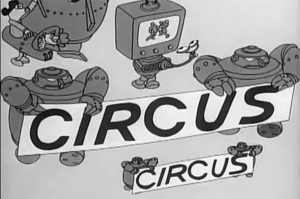 That night, the circus owner sternly reprimands Astro for not finishing what he started to please the crowd, and threatens to cut off his supplies of power unless Astro shapes up in attitude by the next bout. Astro discovers a pile of other robots in a back supply tent, lying nearly motionless, because they also have fallen from favor in the eyes of the owner or the crowd, and have worn out their usefulness to the circus. They are ready to be junked, and can do nothing about it, as their power is nearly expired due to being deprived of any new recharges by the owner. Astro decides to share voltage from his own battery with them to revive them – all the while depleting some of his own resources. That night, another robot’s stunt of leaping through a circle of high-voltage sparks goes wrong, producing a fire inside the big top. Though almost depleted of his strength, Astro Boy is the only one who can hear the cries for help of the circus owner, pinned down beneath a pole inside the tent. While the other revived robots prove their worth by performing simpler rescues of members of the crowd, Astro, using his last ounce of strength, lifts away the fallen poles, and drags the owner to safety, before collapsing. The scene fades to a hospital room a few weeks later, where the owner is recovering nicely. Professor Elefun, now new head of the institute after the ousting of Astro’s “dad”, has returned to again make a plea for the boy’s freedom. But the owner is as ungrateful as ever. “What am I supposed to do? Say ‘thank you’ to a robot?” The owner insists Astro owes him for being built into a star, and if the Professor chooses, go ahead and sue him, as his ownership papers will surely win in court. But Professor Elefun informs the owner that a lot has been happening in the weeks during his convalescence, and turns on a news broadcast on the TV set. There, thousands of robots cheer in a public square before a congressional building, at the announcement of a robot bill of rights, declaring them all free. In a funny “take”, the owner jerks upward into a sitting position, in shock at the news, the features of his face lingering for a moment in their original place and having to catch up with the rapid rise of his head! Faced with a future of criminal charges if he violates the new law, the owner slaps Elefun across the face, but breaks into pathetic sobbing as he acknowledges defeat. “Coming, Astro Boy?”, says the Professor, tenderly offering Astro his arm, as they leave the hospital together down the corridor.
That night, the circus owner sternly reprimands Astro for not finishing what he started to please the crowd, and threatens to cut off his supplies of power unless Astro shapes up in attitude by the next bout. Astro discovers a pile of other robots in a back supply tent, lying nearly motionless, because they also have fallen from favor in the eyes of the owner or the crowd, and have worn out their usefulness to the circus. They are ready to be junked, and can do nothing about it, as their power is nearly expired due to being deprived of any new recharges by the owner. Astro decides to share voltage from his own battery with them to revive them – all the while depleting some of his own resources. That night, another robot’s stunt of leaping through a circle of high-voltage sparks goes wrong, producing a fire inside the big top. Though almost depleted of his strength, Astro Boy is the only one who can hear the cries for help of the circus owner, pinned down beneath a pole inside the tent. While the other revived robots prove their worth by performing simpler rescues of members of the crowd, Astro, using his last ounce of strength, lifts away the fallen poles, and drags the owner to safety, before collapsing. The scene fades to a hospital room a few weeks later, where the owner is recovering nicely. Professor Elefun, now new head of the institute after the ousting of Astro’s “dad”, has returned to again make a plea for the boy’s freedom. But the owner is as ungrateful as ever. “What am I supposed to do? Say ‘thank you’ to a robot?” The owner insists Astro owes him for being built into a star, and if the Professor chooses, go ahead and sue him, as his ownership papers will surely win in court. But Professor Elefun informs the owner that a lot has been happening in the weeks during his convalescence, and turns on a news broadcast on the TV set. There, thousands of robots cheer in a public square before a congressional building, at the announcement of a robot bill of rights, declaring them all free. In a funny “take”, the owner jerks upward into a sitting position, in shock at the news, the features of his face lingering for a moment in their original place and having to catch up with the rapid rise of his head! Faced with a future of criminal charges if he violates the new law, the owner slaps Elefun across the face, but breaks into pathetic sobbing as he acknowledges defeat. “Coming, Astro Boy?”, says the Professor, tenderly offering Astro his arm, as they leave the hospital together down the corridor.
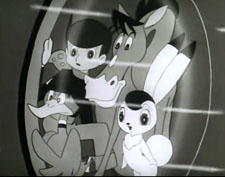 The Amazing 3 (known as “Wonder 3″ in Japan) (Osamu Tezuka/Mushi Productions), was the last black and white anime series to hit the United States. Its sci-fi premise involved three space alien agents, sent to Earth by a galactic federation of planets to determine if war-like and violence-plagued planet Earth is worth preserving, or should be obliterated as an abomination upon the galaxy. The agents, with the aid of their hi-tech gizmos, disguise themselves by merging with the bodies of three typical earth creatures, becoming a cute bunny (Bonnie), a strong horse (Ronnie), and a dimwitted duck (Zero). The duck in particular seems to be heavily influenced by the obnoxious and egotistical traits of the later Daffy Duck personas, with a touch of Donald Duck temper, but with the unique twist of a 60’s Beatle haircut and a talent for playing rock guitar. Assisting them is a teenage boy named Kenny Carter – the only Earthling who has discovered their true identity and mission. Also figuring prominently into most stories is Kenny’s adult brother Randy, whose day-job and cover is as a manga artist, but who in reality is a secret agent for an organization called Phoenix. Randy’s exploits allowed for plenty of Japan’s traditional quota of cartoon violence, most of which seems to have made its way even to the American screen, accounting for the seeming inability of the distributors to find any market for the show in rerun, and the considerable scarcity of the episodes today, with many master negatives as well as most of the American sound dubs considered lost.
The Amazing 3 (known as “Wonder 3″ in Japan) (Osamu Tezuka/Mushi Productions), was the last black and white anime series to hit the United States. Its sci-fi premise involved three space alien agents, sent to Earth by a galactic federation of planets to determine if war-like and violence-plagued planet Earth is worth preserving, or should be obliterated as an abomination upon the galaxy. The agents, with the aid of their hi-tech gizmos, disguise themselves by merging with the bodies of three typical earth creatures, becoming a cute bunny (Bonnie), a strong horse (Ronnie), and a dimwitted duck (Zero). The duck in particular seems to be heavily influenced by the obnoxious and egotistical traits of the later Daffy Duck personas, with a touch of Donald Duck temper, but with the unique twist of a 60’s Beatle haircut and a talent for playing rock guitar. Assisting them is a teenage boy named Kenny Carter – the only Earthling who has discovered their true identity and mission. Also figuring prominently into most stories is Kenny’s adult brother Randy, whose day-job and cover is as a manga artist, but who in reality is a secret agent for an organization called Phoenix. Randy’s exploits allowed for plenty of Japan’s traditional quota of cartoon violence, most of which seems to have made its way even to the American screen, accounting for the seeming inability of the distributors to find any market for the show in rerun, and the considerable scarcity of the episodes today, with many master negatives as well as most of the American sound dubs considered lost.
Phantom of the Circus (7/25/65) has little to do with the aliens’ overall mission = merely allowing them to see another instance of the forces of good battling the forces of evil. An evil organization, Interspy, plans to disrupt a peace conference by planting thirteen time bombs in the location where the conference will take place. A female agent, at first seen only in shadow, lays out the plans to her minions. Then, we cut to Randy, assigned to guard the conference, receiving telephone orders from his own superiors as he drives along in a sports car. Suddenly, a hooded motorcyclist is seen, approaching the car in the opposite direction, but driving right atop the white line in the center of the road, on a collision course with Randy. Randy is barely able to veer out of the way, as the motorcycle passes the car at close range, and something is thrown into the back seat. Randy turns to spot a time bomb resting on the upholstery. There is no time to stop and turn around to remove it, so Randy jumps from the car, allowing it to crash through a railing, fall off a cliff, and explode on the rocks at the canyon bottom. As Randy peers over the edge at the remains of the car, he turns to observe the motorcyclist spinning around to reverse direction, realizing that Randy has not been finished off. The rider flings a dagger at Randy, which pierces his hat, but again misses a mortal wound. Randy pulls out his revolver, and takes a shot at the motorcycle’s front tire, puncturing it. But the skilled rider merely places the cycle into “wheelie” position, and escapes down the road, balanced only upon its rear wheel. Randy removes the dagger from his hat, observing that it bears the aroma of a woman’s perfume.
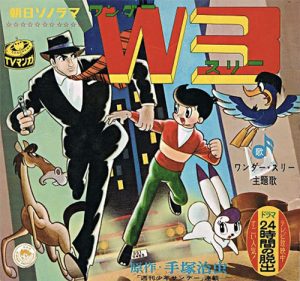 Later, a circus parade hits town, attracting the attention of Kenny and the three disguised aliens. The aliens have never seen a circus, and Bonnie and Ronnie become curious, although Zero dismisses the parading as a mere waste of time. Among the paraders is a performer who, at least to the audience, seems by now conspicuous – a lady motorcycle daredevil, who also rides upon one tire. She of course turns out to be the Interspy agent who gave the orders for the conference bombing, and almost finished Randy. Many other performers of the circus, primarily clowns, are also in upon the plans, also enemy agents. At the circus grounds, Ronnie develops a crush on a graceful filly who gives him a wink of her eye. He and Zero get mixed up with her trainer (a “horse-faced” human who almost looks like a facial twin to Ronnie) when they see him applying a whip to get the mare to obey. The trainer boots Zero into the lion’s cage, where the duck is briefly held by the jaws of the big cat, then tossed by the lion outside the cage bars, into a metal pail. Meanwhile, Kenny and Bonnie take in the show from the grandstand. The girl cyclist doubles in trapeze work, performing a leap through five suspended hoops of fire without a net, then allowing herself to be dropped by another trapeze man to the arena below, where her motorcycle is launched to her down a ramp. She lands in the seat, performs a somersault, then a few loops around the arena and her signature wheelie on her rear tire. Too bad Randy isn’t here, or he’d have his clue. But Bonnie’s already got one. With her large rabbit ears and alien sensitivities, she is able to pick up on a conversation between the girl and her trapeze man just before the girl’s drop to her motorcycle, in which they confirm that everything is set for the 13 bombs at the peace conference, and for the demise of “agent P77″ – Randy’s number.
Later, a circus parade hits town, attracting the attention of Kenny and the three disguised aliens. The aliens have never seen a circus, and Bonnie and Ronnie become curious, although Zero dismisses the parading as a mere waste of time. Among the paraders is a performer who, at least to the audience, seems by now conspicuous – a lady motorcycle daredevil, who also rides upon one tire. She of course turns out to be the Interspy agent who gave the orders for the conference bombing, and almost finished Randy. Many other performers of the circus, primarily clowns, are also in upon the plans, also enemy agents. At the circus grounds, Ronnie develops a crush on a graceful filly who gives him a wink of her eye. He and Zero get mixed up with her trainer (a “horse-faced” human who almost looks like a facial twin to Ronnie) when they see him applying a whip to get the mare to obey. The trainer boots Zero into the lion’s cage, where the duck is briefly held by the jaws of the big cat, then tossed by the lion outside the cage bars, into a metal pail. Meanwhile, Kenny and Bonnie take in the show from the grandstand. The girl cyclist doubles in trapeze work, performing a leap through five suspended hoops of fire without a net, then allowing herself to be dropped by another trapeze man to the arena below, where her motorcycle is launched to her down a ramp. She lands in the seat, performs a somersault, then a few loops around the arena and her signature wheelie on her rear tire. Too bad Randy isn’t here, or he’d have his clue. But Bonnie’s already got one. With her large rabbit ears and alien sensitivities, she is able to pick up on a conversation between the girl and her trapeze man just before the girl’s drop to her motorcycle, in which they confirm that everything is set for the 13 bombs at the peace conference, and for the demise of “agent P77″ – Randy’s number.
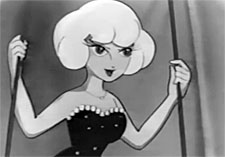 Speaking of Randy, the agent is on the run, back to the nearest town, in search of a lead on the mystery cyclist, and also looking for a new suit to replace the one damaged in the afternoon’s activities. He finds a tailor shop for quick acquisition of a new suit. He also spies an ad on the wall for the circus, and hears from the tailor of their cycle stunts this season. Randy follows the lead, arriving at the circus grounds. He encounters the girl, but stupidly seems so smitten by her appearance and the scent of her perfume, he fails to put two and two together as to where he smelled that scent before. (He’s as bad as Rocky Squirrel’s always-delayed ability to tell where he’s previously seen Boris Badenov.) The girl gives a signal to one of the clowns, who carelessly tips over a bucket of whitewash, splattering it upon Randy’s shoes. The girl apologizes for the clown’s carelessness, and orders the clown to retrieve a new pair of shoes for Randy from the prop tent. Randy ultimately accepts the free gift, and walks off with the new footwear, while the girl and clown confirm that the timer in one of the shoes has been set to detonate along with the other bombs left at the peace conference.
Speaking of Randy, the agent is on the run, back to the nearest town, in search of a lead on the mystery cyclist, and also looking for a new suit to replace the one damaged in the afternoon’s activities. He finds a tailor shop for quick acquisition of a new suit. He also spies an ad on the wall for the circus, and hears from the tailor of their cycle stunts this season. Randy follows the lead, arriving at the circus grounds. He encounters the girl, but stupidly seems so smitten by her appearance and the scent of her perfume, he fails to put two and two together as to where he smelled that scent before. (He’s as bad as Rocky Squirrel’s always-delayed ability to tell where he’s previously seen Boris Badenov.) The girl gives a signal to one of the clowns, who carelessly tips over a bucket of whitewash, splattering it upon Randy’s shoes. The girl apologizes for the clown’s carelessness, and orders the clown to retrieve a new pair of shoes for Randy from the prop tent. Randy ultimately accepts the free gift, and walks off with the new footwear, while the girl and clown confirm that the timer in one of the shoes has been set to detonate along with the other bombs left at the peace conference.
Somehow, the horse trainer has captured and held Zero and Ronnie, and pushes them out next into the arena to perform an act. Ronnie rears up at having a whip cracked at him, falling backwards to land sitting on Zero. Zero squawks once he is freed, and again is given the boot by the trainer, landing in the circus orchestra bandstand. He stumbles back into the spotlight, his head stuck in the hole of a guitar. Once he pries the instrument off, Zero takes control of the situation, strumming the guitar and quacking his own improvised tune. Ronnie begins dancing to it with his hindquarters, and the two score a hit with the crowd. Zero scores his own further hit, making his exit by smashing the guitar over the trainer’s head.
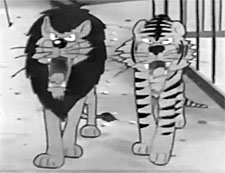 With everything set for the peace conference’s destruction, the girl and her clowns decide it’s time to ditch this circus facade. They create a disruption by opening the cages of most of the menagerie, letting the wild beasts loose. At the same time, Randy, interviewing the circus owner, learns that the girl he met is also the circus cyclist, and investigates her empty dressing room, finding a bottle of the tell-tale perfume. Randy finally gets it that he has found his suspect. As the public flees in panic, and Kenny and the alien 3 are surrounded by several of the larger, fiercer animals, Zero proves himself useful, by addressing the beasts in animal talk, convincing them that they are causing chaos unnecessarily, and if they’ll all go back to their cages, he’s sure there will be no repercussions. Somehow finding the guitar again, Zero marches the animals back to their cages in pied-piper fashion, where all voluntarily assume their proper places to be locked back up. Peering from a nearby tent, the girl and her clowns can’t believe what they’ve just seen the duck do. But they have another surprise. Randy has crept up on them, gun drawn. A pistol-battle ensues, but Randy dodges all shots. Some fisticuffs and high kicks, and the clowns are temporarily immobilized and disarmed. The girl climbs to a trapeze platform, with Randy right behind. She pulls out a small stiletto, slicing away at the rope ladder to which Randy clings below. Randy uses a secret-agent gadget to save himself from a fall – a mini-grappling hook shot from his wristwatch, which wraps itself around a trapeze above. As Randy hangs from the trapeze, the girl hangs onto another with her feet, wielding the stiletto in her hands. She swings closer and closer to Randy, jabbing left and right in attempt to stab him. Randy fights fire with fire, putting his own trapeze into an increasing swing, until he is able to bump and knock the girl loose from her own trapeze. She falls to the arena sawdust, but somehow survives with nothing more than a momentary pause. Rising from the ground, she tosses the stiletto, severing one cord holding up Randy’s trapeze. Now Randy falls, and to make sure he stays helpless, one of the clowns applies a knockout blow to his head with the butt of a gun.
With everything set for the peace conference’s destruction, the girl and her clowns decide it’s time to ditch this circus facade. They create a disruption by opening the cages of most of the menagerie, letting the wild beasts loose. At the same time, Randy, interviewing the circus owner, learns that the girl he met is also the circus cyclist, and investigates her empty dressing room, finding a bottle of the tell-tale perfume. Randy finally gets it that he has found his suspect. As the public flees in panic, and Kenny and the alien 3 are surrounded by several of the larger, fiercer animals, Zero proves himself useful, by addressing the beasts in animal talk, convincing them that they are causing chaos unnecessarily, and if they’ll all go back to their cages, he’s sure there will be no repercussions. Somehow finding the guitar again, Zero marches the animals back to their cages in pied-piper fashion, where all voluntarily assume their proper places to be locked back up. Peering from a nearby tent, the girl and her clowns can’t believe what they’ve just seen the duck do. But they have another surprise. Randy has crept up on them, gun drawn. A pistol-battle ensues, but Randy dodges all shots. Some fisticuffs and high kicks, and the clowns are temporarily immobilized and disarmed. The girl climbs to a trapeze platform, with Randy right behind. She pulls out a small stiletto, slicing away at the rope ladder to which Randy clings below. Randy uses a secret-agent gadget to save himself from a fall – a mini-grappling hook shot from his wristwatch, which wraps itself around a trapeze above. As Randy hangs from the trapeze, the girl hangs onto another with her feet, wielding the stiletto in her hands. She swings closer and closer to Randy, jabbing left and right in attempt to stab him. Randy fights fire with fire, putting his own trapeze into an increasing swing, until he is able to bump and knock the girl loose from her own trapeze. She falls to the arena sawdust, but somehow survives with nothing more than a momentary pause. Rising from the ground, she tosses the stiletto, severing one cord holding up Randy’s trapeze. Now Randy falls, and to make sure he stays helpless, one of the clowns applies a knockout blow to his head with the butt of a gun.
A quick getaway is now in order. The girl suggests using a horse – the same horse Ronnie considers his girlfriend. Ronnie comes to his lady love’s defense, delivering several well-placed kicks and bucks that leave the clowns and the girl lying in a heap, just as Randy comes to. As Randy attempts to make an arrest of the girl, she lets slip that the peace conference is doomed. Something may be lost in translation here, as several shots do not appear to match the mood or content of dialogue, and even though it is my recollection that Randy does not know of Bonnie’s or the other aliens’ ability to speak, Kenny appears, informing him that Bonnie heard about 13 time bombs at the conference. (What happened?) Even more indicative that in the original, Randy was not actually informed of the bombs, he gets himself wrapped up in pursuit of the escaping girl, rather than racing to the conference to prevent the mass murder. The task of saving the delegates falls upon Kenny and the Amazing 3. Aboard Ronnie, they gallop to the conference hall, bursting in through a large glass window. Kenny shouts to the delegation to evacuate, as someone has planted bombs in the room. Without question of where he got the information, the room is cleared out in a matter of seconds. Bonnie sets upon the task of an eleventh-hour hide-and-seek game, listening with her supersonic hearing for the telltale ticking of the bombs. Eleven bombs are quickly located by her, and deactivated by Zero, with Kenny adding an assist by spotting a twelfth in the chandelier which Bonnie missed. But try as she might, Bonnie can’t hear any ticks from the 13th bomb. She suddenly remembers that she had heard the same type of ticking earlier that afternoon – when Randy passed her. The last bomb is planted on Randy.
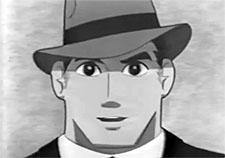 At the base of a mountain cliff, Randy has cornered the girl cyclist. Her behavior is strange, as she seems more concerned about keeping her distance from Randy than about being caught. Kenny, Ronnie, and the others gallop up, Kenny shouting to Randy that there is a bomb planted on him. Randy puzzles as to where it could be placed, frisking himself from ankle to head. With the jig essentially up, and nowhere to run, the girl finally confesses, “Your shoe!” Randy removes one, and hears it ticking. He tosses it at the girl, who tosses ir ro Kenny, who tosses it to Bonnie, who tosses it to Zero, in a fatal game of hot potato. Zero heroically (and egotistically) decides that once again it is up to him to save the day from these ignorant humans, and, placing the shoe upon one webbed foot to free his wings for use, flies with the shoe into the sky. He attempts to release the shoe to drop where it will cause no harm, but finds it stuck tight to his webbed foot. He pries and pries at it, as the final seconds tick down. BOOM! Kenny winces at what may have occurred, but the situation is handled in Western cartoon fashion, as Zero emerges from the smoke cloud, his feathers charred to a crisp and all falling away, leaving him a denuded duck, to helplessly fall to the ground with a thud. That night, Randy takes his lovely prisoner along with him in handcuffs, while Kenny asks Zero what he thinks of the circus now. “And they call this fun?” Zero snarls, riding atop Ronnie, some of his feathers grown back but wearing bandages and with one wing in a cast, rubbing his sore arm with a grimace of pain, for the fade out.
At the base of a mountain cliff, Randy has cornered the girl cyclist. Her behavior is strange, as she seems more concerned about keeping her distance from Randy than about being caught. Kenny, Ronnie, and the others gallop up, Kenny shouting to Randy that there is a bomb planted on him. Randy puzzles as to where it could be placed, frisking himself from ankle to head. With the jig essentially up, and nowhere to run, the girl finally confesses, “Your shoe!” Randy removes one, and hears it ticking. He tosses it at the girl, who tosses ir ro Kenny, who tosses it to Bonnie, who tosses it to Zero, in a fatal game of hot potato. Zero heroically (and egotistically) decides that once again it is up to him to save the day from these ignorant humans, and, placing the shoe upon one webbed foot to free his wings for use, flies with the shoe into the sky. He attempts to release the shoe to drop where it will cause no harm, but finds it stuck tight to his webbed foot. He pries and pries at it, as the final seconds tick down. BOOM! Kenny winces at what may have occurred, but the situation is handled in Western cartoon fashion, as Zero emerges from the smoke cloud, his feathers charred to a crisp and all falling away, leaving him a denuded duck, to helplessly fall to the ground with a thud. That night, Randy takes his lovely prisoner along with him in handcuffs, while Kenny asks Zero what he thinks of the circus now. “And they call this fun?” Zero snarls, riding atop Ronnie, some of his feathers grown back but wearing bandages and with one wing in a cast, rubbing his sore arm with a grimace of pain, for the fade out.
 I choose not to write elaborately upon Kimba the White Lion (Osamu Tezuka, Mushi Productions), as it seems from what Info I have available that Kimba never actually reached a circus for a storyline. One episode seems to have a circus connection – a strange pre-jungle encounter of Kimba with human civilization in, of all places, Paris, commonly known in translation as Fair Game (11/3/65). The story seems to involve an encounter between Kimba and an elderly escaped circus leopard holed up in the sewers of Paris, as related by Kimba to the leopard’s grandson. However, the episode has undergone so much cutting, censoring, and redubbing in various versions that I am unable to definitively discern its original intended storyline, which seems to vary from the leopard sacrificing his life by taking a bullet to save Kimba, to a version which may include new shots where the leopard survives and the entire jungle visits the Paris World’s Fair! As no subtitled version of the Japanese original has been locatable in my research, I leave it to the reader to figure out what this story was really all about.
I choose not to write elaborately upon Kimba the White Lion (Osamu Tezuka, Mushi Productions), as it seems from what Info I have available that Kimba never actually reached a circus for a storyline. One episode seems to have a circus connection – a strange pre-jungle encounter of Kimba with human civilization in, of all places, Paris, commonly known in translation as Fair Game (11/3/65). The story seems to involve an encounter between Kimba and an elderly escaped circus leopard holed up in the sewers of Paris, as related by Kimba to the leopard’s grandson. However, the episode has undergone so much cutting, censoring, and redubbing in various versions that I am unable to definitively discern its original intended storyline, which seems to vary from the leopard sacrificing his life by taking a bullet to save Kimba, to a version which may include new shots where the leopard survives and the entire jungle visits the Paris World’s Fair! As no subtitled version of the Japanese original has been locatable in my research, I leave it to the reader to figure out what this story was really all about.
 Girl Daredevil (aka “The Secret Treasure of Niagara”) (Speed Racer – Tatsuo Yoshida/Tatsunoko Productions, 7/30 – 8/6/67) – While driving through town, Speed, Trixie, Spritel and Chim-Chim witness an astonishing sight. Atop a building about 40 stores tall stands a shapely girl in flashy circus tights and skirt. She leaps from the building, causing the crowd below to gasp in terror. However, she lands safely in a large net rigged up along one side of the building, bounces gracefully off the net, and plants a landing in a majestic pose on her feet on the pavement. The crowd cheers, and a clown announces her name as Twinkle Banks, and her performance tonight at the Universal Circus. Speed is Mesmorized in awe, while Trixie (who waves her hand in front of Speed’s eyes in attempt to bring him back to planet Earth) assumes a position of obstinance and jealousy at the idea of going to see this show-off. Only the insistent wailing of Spritel and Chim-Chim is annoying enough to sway Trixie to go to the show, just to shut them up.
Girl Daredevil (aka “The Secret Treasure of Niagara”) (Speed Racer – Tatsuo Yoshida/Tatsunoko Productions, 7/30 – 8/6/67) – While driving through town, Speed, Trixie, Spritel and Chim-Chim witness an astonishing sight. Atop a building about 40 stores tall stands a shapely girl in flashy circus tights and skirt. She leaps from the building, causing the crowd below to gasp in terror. However, she lands safely in a large net rigged up along one side of the building, bounces gracefully off the net, and plants a landing in a majestic pose on her feet on the pavement. The crowd cheers, and a clown announces her name as Twinkle Banks, and her performance tonight at the Universal Circus. Speed is Mesmorized in awe, while Trixie (who waves her hand in front of Speed’s eyes in attempt to bring him back to planet Earth) assumes a position of obstinance and jealousy at the idea of going to see this show-off. Only the insistent wailing of Spritel and Chim-Chim is annoying enough to sway Trixie to go to the show, just to shut them up.
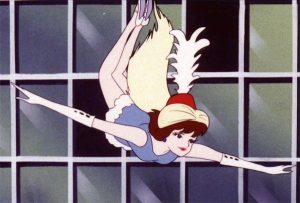 At the show, Chim-Chim gets to briefly do something more than merely act like a chimpanzee, when he spies and falls instantly in love with a performing girl monkey in the opening parade. Grabbing a top hat and a fancy costume from a dressing room, Chim-Chim poses as a simian “great lover”, conking out the girl chimp’s boyfriend with an Indian club, and taking his place at the wheel of an exotic steam-driven vehicle. Unfortunately, he is not much at driving, and crashes into a gorilla cage, where he is knocked about by the larger ape, and also receives a slap from the girl for being so clumsy. But the main attraction of the performance is Twinkle, who takes the wheel of a speedy-looking racing car in the center of a large banked track filling most of the arena. Twinkle steers the car onto the track, and guns the engine. Round and round she goes, until her vehicle circles at lightning speed around the highest point of the angled bank track, at nearly a right-angle to the ground. At a master control on the sidelines, the clown pulls a lever with some difficulty. When the gears engage, a set of hydraulic lifts raise the entire circular track skyward, still bearing Twinkle’s circling car, held fast to the track walls by centrifugal force. Twinkle’s car seems somehow equipped with settings to lock the accelerator into a set speed, and, with the car still circling, she climbs out of its open cab, and performs a handstand on the car’s hood. Speed below remarks that she’s great, but this stunt looks plenty dangerous, with any misstep likely to result in disaster. The time comes to lower the track, but the master control lever malfunctions entirely, and the track will not lower from its position.
At the show, Chim-Chim gets to briefly do something more than merely act like a chimpanzee, when he spies and falls instantly in love with a performing girl monkey in the opening parade. Grabbing a top hat and a fancy costume from a dressing room, Chim-Chim poses as a simian “great lover”, conking out the girl chimp’s boyfriend with an Indian club, and taking his place at the wheel of an exotic steam-driven vehicle. Unfortunately, he is not much at driving, and crashes into a gorilla cage, where he is knocked about by the larger ape, and also receives a slap from the girl for being so clumsy. But the main attraction of the performance is Twinkle, who takes the wheel of a speedy-looking racing car in the center of a large banked track filling most of the arena. Twinkle steers the car onto the track, and guns the engine. Round and round she goes, until her vehicle circles at lightning speed around the highest point of the angled bank track, at nearly a right-angle to the ground. At a master control on the sidelines, the clown pulls a lever with some difficulty. When the gears engage, a set of hydraulic lifts raise the entire circular track skyward, still bearing Twinkle’s circling car, held fast to the track walls by centrifugal force. Twinkle’s car seems somehow equipped with settings to lock the accelerator into a set speed, and, with the car still circling, she climbs out of its open cab, and performs a handstand on the car’s hood. Speed below remarks that she’s great, but this stunt looks plenty dangerous, with any misstep likely to result in disaster. The time comes to lower the track, but the master control lever malfunctions entirely, and the track will not lower from its position.
Speed realizes she’s been up there too long, and finds out from the clown about the problem. Speed realizes that if the engine overheats or the car runs out of gas, Twinkle is done for. Twinkle herself knows something is direly wrong, and, fearing for her life, collapses at the wheel in a faint, the car continuing at its set speed round and round. Speed takes a desperate chance to save her. Climbing to the top of a tent pole, Speed swings on a rope over to the upper lip of the circular track. Impossibly gauging his timing, Speed jumps from the track edge, landing in the cab of the speeding car. Taking over the controls, Speed employs a calculated risk. Rather than attempt to slow the car, Speed speeds up. The added force begins to tell upon the track structure, causing the entire structure to sway violently back and forth. The asphalt surface of the track begins to crack and crumble. When Speed believes enough speed has been obtained, he allows the car to toss himself, carrying Twinkle, out of the cab and over the upper edge of the track wall. Miraculously, they manage to be ejected directly onto a large trapeze platform. The track cracks through, and the abandoned car crashes through its surface, flying through the air, and smashing at the base of one of the side walls of the big top, where it bursts into flame. (We do not see how the blaze is extinguished, but merely go to a fade out.)
 Again, it is possible something has been lost in translation. Watching all of this, and claiming that the incident fits into his plans, is one Mr. Cornpone (last name indecipherable), who appears to be a fat investor in the circus. It is uncertain whether he sabotaged the track mechanism, or whether its malfunction was merely a coincidence, as we learn in a hospital room where Twinkle is recovering from the shock of her ordeal, from the clown (her father), that the circus has hit on hard financial times and they haven’t been able to afford proper upkeep on the equipment. Speed chips in some cash in hopes of putting the show back on its feet, and even Spritel and Chim-Chim dig into their pockets for their available candy. But more seems needed to keep the show afloat, and Twinkle and her dad turn to Cornpone. The next day, the circus has left town. Speed hears a radio announcement for a spectacular feat to be performed over Niagara Falls. A car will attempt to traverse the span of the falls on twin tightropes. The publicity stunt has been proposed and financed by Cornpone, who has led Twinkle and her father to believe it will really put their circus on the map as an attraction. Speed, however, realizes the extreme danger of keeping a car balanced on two wires – especially if the wind should cause the wires to sway and separate from one another. As Speed and Trixie race toward Niagara, they hear weather reports worsen, with greater winds predicted on the Canadian side of the falls, and possible outbreak of a storm. Twinkle’s dad hears it too, and tries to cancel the event. But Cornpone has Dad seized by several thugs, and insists he has paid for the event, and it will go on. Cornpone impersonates Dad in a clown suit, getting Twinkle ready for her performance. Why? It turns out Cornpone is a master international thief, and intends to use the performance as a distraction to his own operation timed to simultaneously occur at the base of the falls, where he prepares to have a large pipe placed through the falls’ water as a tunnel to a rumored Indian cavern beneath the falls, where he believes a hidden treasure is located. (Far-fetched that no one else has explored it? Yes, indeed. But then, so was the later Touchstone feature “National Treasure II”, to which portions of this plot bear some resemblance.)
Again, it is possible something has been lost in translation. Watching all of this, and claiming that the incident fits into his plans, is one Mr. Cornpone (last name indecipherable), who appears to be a fat investor in the circus. It is uncertain whether he sabotaged the track mechanism, or whether its malfunction was merely a coincidence, as we learn in a hospital room where Twinkle is recovering from the shock of her ordeal, from the clown (her father), that the circus has hit on hard financial times and they haven’t been able to afford proper upkeep on the equipment. Speed chips in some cash in hopes of putting the show back on its feet, and even Spritel and Chim-Chim dig into their pockets for their available candy. But more seems needed to keep the show afloat, and Twinkle and her dad turn to Cornpone. The next day, the circus has left town. Speed hears a radio announcement for a spectacular feat to be performed over Niagara Falls. A car will attempt to traverse the span of the falls on twin tightropes. The publicity stunt has been proposed and financed by Cornpone, who has led Twinkle and her father to believe it will really put their circus on the map as an attraction. Speed, however, realizes the extreme danger of keeping a car balanced on two wires – especially if the wind should cause the wires to sway and separate from one another. As Speed and Trixie race toward Niagara, they hear weather reports worsen, with greater winds predicted on the Canadian side of the falls, and possible outbreak of a storm. Twinkle’s dad hears it too, and tries to cancel the event. But Cornpone has Dad seized by several thugs, and insists he has paid for the event, and it will go on. Cornpone impersonates Dad in a clown suit, getting Twinkle ready for her performance. Why? It turns out Cornpone is a master international thief, and intends to use the performance as a distraction to his own operation timed to simultaneously occur at the base of the falls, where he prepares to have a large pipe placed through the falls’ water as a tunnel to a rumored Indian cavern beneath the falls, where he believes a hidden treasure is located. (Far-fetched that no one else has explored it? Yes, indeed. But then, so was the later Touchstone feature “National Treasure II”, to which portions of this plot bear some resemblance.)
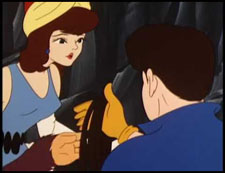 Twinkle begins her treacherous drive. Sure enough, the winds pick up. The wires sway violently, and the car is thrown off the wires, falling into the falls. Twinkle leaps from the car just n time to catch one of the wires with her hands, and hangs there desperately for life. Speed arrives, and is soon followed by his mechanic, who had been chasing Speed all the way to the falls to complete a modification job on the car. The two of them remove the Mach V’s tires, placing the car upon the wires by the wheels’ metal rims, which are slotted to act like the wheels of a railroad train to provide a bit more safety in gripping the wires and holding them together. Speed cautiously rolls out across the falls, reaching the halfway point, and stopping the car to haul up Twinkle from her precarious perch. Speed claims backing up would be more dangerous than proceeding forward, so attempts to complete the crossing. But the winds kick up again, and one cable snaps. Speed and Twinkle miraculously balance the Mach V with two tires on one line, until the second cable snaps too. The Mach V plummets into the falls. But being equipped for underwater running, Speed seals the cockpit, and tries to maneuver the car on the bottom. The currents, however, are too great for the car to traverse its way to the river bank, and the car repeatedly gets sucked backwards into a whirlpool. The cockpit air supply runs out, and Speed and Twinkle briefly pass out. But somehow, there is enough air left for Speed to revive, long enough to also remember fabled stories of the Indian cave beneath the falls, which he attempts to find by driving toward the falls instead of away from them. Somehow, he comes up inside a hidden lagoon inside the caverns. (Amazing that he found this way in, instead of being blocked by the tunnel pipe already installed during the act by Cornpone.) Cornpone is already there, and has already found the treasure, so orders Speed and Twinkle tied up to keep them quiet. A henchman reports from the tunnel that police are climbing down into the canyon in search of the fallen cars, and Cornpone orders a dynamite blast to seal the tunnel entrance. Cornpone already has located an old map which shows a back way out of the cavern through a maze of tunnels, only one of which leads to an exit. They hijack the Mach V and make a getaway. Twinkle turns out to have escape artist skills as another credential of her circus training, and is soon free of the ropes and able to untie Speed. Leaving the caverns is much easier than Cornpone surmised, as Speed simply follows the tire tracks left by the Mach V.
Twinkle begins her treacherous drive. Sure enough, the winds pick up. The wires sway violently, and the car is thrown off the wires, falling into the falls. Twinkle leaps from the car just n time to catch one of the wires with her hands, and hangs there desperately for life. Speed arrives, and is soon followed by his mechanic, who had been chasing Speed all the way to the falls to complete a modification job on the car. The two of them remove the Mach V’s tires, placing the car upon the wires by the wheels’ metal rims, which are slotted to act like the wheels of a railroad train to provide a bit more safety in gripping the wires and holding them together. Speed cautiously rolls out across the falls, reaching the halfway point, and stopping the car to haul up Twinkle from her precarious perch. Speed claims backing up would be more dangerous than proceeding forward, so attempts to complete the crossing. But the winds kick up again, and one cable snaps. Speed and Twinkle miraculously balance the Mach V with two tires on one line, until the second cable snaps too. The Mach V plummets into the falls. But being equipped for underwater running, Speed seals the cockpit, and tries to maneuver the car on the bottom. The currents, however, are too great for the car to traverse its way to the river bank, and the car repeatedly gets sucked backwards into a whirlpool. The cockpit air supply runs out, and Speed and Twinkle briefly pass out. But somehow, there is enough air left for Speed to revive, long enough to also remember fabled stories of the Indian cave beneath the falls, which he attempts to find by driving toward the falls instead of away from them. Somehow, he comes up inside a hidden lagoon inside the caverns. (Amazing that he found this way in, instead of being blocked by the tunnel pipe already installed during the act by Cornpone.) Cornpone is already there, and has already found the treasure, so orders Speed and Twinkle tied up to keep them quiet. A henchman reports from the tunnel that police are climbing down into the canyon in search of the fallen cars, and Cornpone orders a dynamite blast to seal the tunnel entrance. Cornpone already has located an old map which shows a back way out of the cavern through a maze of tunnels, only one of which leads to an exit. They hijack the Mach V and make a getaway. Twinkle turns out to have escape artist skills as another credential of her circus training, and is soon free of the ropes and able to untie Speed. Leaving the caverns is much easier than Cornpone surmised, as Speed simply follows the tire tracks left by the Mach V.
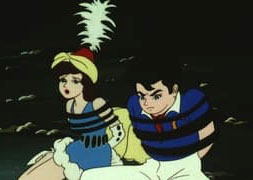 Things get far off-track for our purposes, as a pursuit of the villains leads across several states, climaxing inside a villain’s lair buried deep within Mount Rushmore in South Dakota. (I told you there were similarities to “National Treasure II”.) There, Speed and Twinkle (with Spritle and Chim-Chim in the trunk) battle a room full of circus panthers with the Mach V, using many elements of its fancy gadgetry including the power jacks, the buzz-saws, and the homing robot. Dad is found a prisoner in a double cage, the other occupant of which is a ferocious lion, with Cornpone opening a gate to bring the two together. Twinkle reminds Dad of his youthful days, when he had fearlessly faced such beasts, with emphasis that you could always control them if you showed no fear. Dad regains his youthful composure, and battles back the lion into submission and non-aggression. Somehow, through many complications, the Mach V escapes the underground compound with Twinkle and Dad, and the villains are brought to justice. The film ends with Twinkle repeating the Niagara Falls stunt on a less windy day. One cable snaps again, but Twinkle and a clown repeat the wheel-balancing bit on one wire, this time successfully completing the passage. Under the make-up, the clown turns out to be Speed, for the fade out.
Things get far off-track for our purposes, as a pursuit of the villains leads across several states, climaxing inside a villain’s lair buried deep within Mount Rushmore in South Dakota. (I told you there were similarities to “National Treasure II”.) There, Speed and Twinkle (with Spritle and Chim-Chim in the trunk) battle a room full of circus panthers with the Mach V, using many elements of its fancy gadgetry including the power jacks, the buzz-saws, and the homing robot. Dad is found a prisoner in a double cage, the other occupant of which is a ferocious lion, with Cornpone opening a gate to bring the two together. Twinkle reminds Dad of his youthful days, when he had fearlessly faced such beasts, with emphasis that you could always control them if you showed no fear. Dad regains his youthful composure, and battles back the lion into submission and non-aggression. Somehow, through many complications, the Mach V escapes the underground compound with Twinkle and Dad, and the villains are brought to justice. The film ends with Twinkle repeating the Niagara Falls stunt on a less windy day. One cable snaps again, but Twinkle and a clown repeat the wheel-balancing bit on one wire, this time successfully completing the passage. Under the make-up, the clown turns out to be Speed, for the fade out.
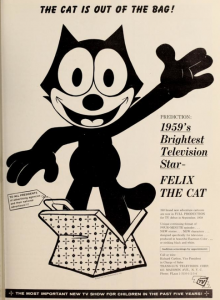 Felix’s Gold Mine (Felix the Cat, circa 1960-61, Joe Oriolo, producer) – Someone has just struck it rich at the Assay Office – and that someone is Felix. As the cat rakes in cash for sack after sack of gold ore, Rock Bottom and the Professor take in the view from outside the window. The Professor get dizzy at the sight of so much wealth, stating “It’s a chronic condition”. They follow Felix across the desert to mesa country, and through a telescope observe Felix use his magic bag to produce a portable jack-like elevator, to lift him to the top of what appears to be a mile-high mesa in the clouds. At the top stands a small sign over an excavated hole, reading “Felix’s Gold Mine”. The cat descends via a stairway he has carved into the rock, entering a cavern loaded with gold nuggets, which he shovels vigorously into sacks. At the foot of the mesa, Rock and the Professor both try to use Felix’s elevator, but the magic bag refuses to cooperate, bending into an arc under their weight, and depositing each of them upside down on the ground. The Professor realizes another way must be found to reach the peak. Meanwhile, their monkeying with the bag has left Felix above without a platform, so that when the cat steps off the cliff edge, he is left standing on air. He drops his latest sacks (which fortunately land on the cliff), and finds himself hanging by his hands from the edge of the mesa, with a long way down below his feet. Below, the Professor acquires a cannon, intending at first to shoot Rock upwards. But Rock is too wide at the midriff to insert in the muzzle, leading the Professor to observe he’s not the right caliber for this job. The Professor takes his place in the cannon barrel, while Rock attempts a countdown to lighting the fuse. “Er, what comes after eight, Professor?” “Seven, stupid!”, yells the Professor. Rock counts, “Seven, stupid, six, five…”, then finally fires. The aim is off, and the Professor overshoots the peak, though catching hold of Felix’s rear end on his pass, restoring the cat to the safety of the mesa peak. The Professor makes a slow descent with a strapped-on parachute, then starts mulling over what to do next with Rock. “By the way, weren’t you with a circus once?”, the Professor asks Rock.
Felix’s Gold Mine (Felix the Cat, circa 1960-61, Joe Oriolo, producer) – Someone has just struck it rich at the Assay Office – and that someone is Felix. As the cat rakes in cash for sack after sack of gold ore, Rock Bottom and the Professor take in the view from outside the window. The Professor get dizzy at the sight of so much wealth, stating “It’s a chronic condition”. They follow Felix across the desert to mesa country, and through a telescope observe Felix use his magic bag to produce a portable jack-like elevator, to lift him to the top of what appears to be a mile-high mesa in the clouds. At the top stands a small sign over an excavated hole, reading “Felix’s Gold Mine”. The cat descends via a stairway he has carved into the rock, entering a cavern loaded with gold nuggets, which he shovels vigorously into sacks. At the foot of the mesa, Rock and the Professor both try to use Felix’s elevator, but the magic bag refuses to cooperate, bending into an arc under their weight, and depositing each of them upside down on the ground. The Professor realizes another way must be found to reach the peak. Meanwhile, their monkeying with the bag has left Felix above without a platform, so that when the cat steps off the cliff edge, he is left standing on air. He drops his latest sacks (which fortunately land on the cliff), and finds himself hanging by his hands from the edge of the mesa, with a long way down below his feet. Below, the Professor acquires a cannon, intending at first to shoot Rock upwards. But Rock is too wide at the midriff to insert in the muzzle, leading the Professor to observe he’s not the right caliber for this job. The Professor takes his place in the cannon barrel, while Rock attempts a countdown to lighting the fuse. “Er, what comes after eight, Professor?” “Seven, stupid!”, yells the Professor. Rock counts, “Seven, stupid, six, five…”, then finally fires. The aim is off, and the Professor overshoots the peak, though catching hold of Felix’s rear end on his pass, restoring the cat to the safety of the mesa peak. The Professor makes a slow descent with a strapped-on parachute, then starts mulling over what to do next with Rock. “By the way, weren’t you with a circus once?”, the Professor asks Rock.
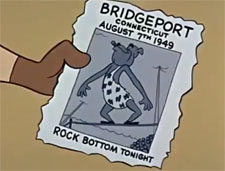 “Yeah. I just happen to have this with me”, responds Rock, producing an old newspaper clipping from a Bridgeport, Connecticut newspaper dated August 7th, 1949, advertising his performance as a slender young dog on tightrope. “You’re just the man I need”, states the Professor. As Felix performs his trademark thinking-walk atop the mesa, another cannon blast is heard. This time, an anchor is launched to the mesa surface, tied to a long rope – the other end fastened to the cannon. “To the summit”, shouts the Professor, sitting on the shoulders of Rock, who, dressed in a leopard-skin leotard, scales the angled rope to the top. Felix thinks they’re trying to rescue him, but the villains leap right past him into the hole of the gold mine, and emerge carrying four sacks of gold. Rock steps onto the rope, and performs a slide-for-life down its angled span. However, a cutaway shot shows us two pelicans, who have landed upon the rope, just ahead of Rock’s feet. We cut to a close-shot of Rock and the Professor, as Rock remarks, “Just like flying, huh?” “Flying?” responds the Professor (in a typical continuity mistake for the series, where his facial expression fails to change to recognition of a problem in time to match his dialogue line). The two crooks finally look down, to find Rock’s feet firmly planted upon each of the pelicans’ backs, with the birds now in flight, carrying the villains away high into the sky, and leaving them looking helplessly back at the mesa from overhead as they drop ther sacks of loot. In the last shot of the film, Felix has somehow recovered the sacks, and uses the rope to slide himself to freedom and another trip to the Assay Office, giving us his trademark laugh.
“Yeah. I just happen to have this with me”, responds Rock, producing an old newspaper clipping from a Bridgeport, Connecticut newspaper dated August 7th, 1949, advertising his performance as a slender young dog on tightrope. “You’re just the man I need”, states the Professor. As Felix performs his trademark thinking-walk atop the mesa, another cannon blast is heard. This time, an anchor is launched to the mesa surface, tied to a long rope – the other end fastened to the cannon. “To the summit”, shouts the Professor, sitting on the shoulders of Rock, who, dressed in a leopard-skin leotard, scales the angled rope to the top. Felix thinks they’re trying to rescue him, but the villains leap right past him into the hole of the gold mine, and emerge carrying four sacks of gold. Rock steps onto the rope, and performs a slide-for-life down its angled span. However, a cutaway shot shows us two pelicans, who have landed upon the rope, just ahead of Rock’s feet. We cut to a close-shot of Rock and the Professor, as Rock remarks, “Just like flying, huh?” “Flying?” responds the Professor (in a typical continuity mistake for the series, where his facial expression fails to change to recognition of a problem in time to match his dialogue line). The two crooks finally look down, to find Rock’s feet firmly planted upon each of the pelicans’ backs, with the birds now in flight, carrying the villains away high into the sky, and leaving them looking helplessly back at the mesa from overhead as they drop ther sacks of loot. In the last shot of the film, Felix has somehow recovered the sacks, and uses the rope to slide himself to freedom and another trip to the Assay Office, giving us his trademark laugh.
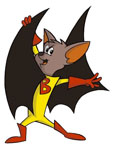 Hal Seeger’s “Batfink” series provides three circus-related episodes, all with new villains instead of Hugo a-Go Go. The first is Ringading Brothers (3/1/67) – A traveling circus wagon truck contains a duo of performers known as the Ringading Brothers – one acrobat, one ringmaster – who have turned to a life of crime. They wear the booty of two previous heists, each one wearing a priceless jeweled ring. They give it another go at a new residence of their choosing, opening a trap door in the roof of their truck to raise two telescoping poles with a trapeze strung between them. The acrobat brother rides the trapeze to full extension, then swings and leaps toward the house, sailing through the air, catching a tree limb for a spinning rwirl, then flying from the limb into an open window of the house. He exits the house in reverse, wearing another valuable ring, catching the trapeze to be lowered into the truck, and leaving no tracks to trace a getaway. But it doesn’t take a super-crimefighter to get a clue on ths caper. Batfink is amazed when the dimwitted police chief seems to have deduced the entire method by which the crooks gained entry – until the chief lets slip, “The butler saw the whole thing.”
Hal Seeger’s “Batfink” series provides three circus-related episodes, all with new villains instead of Hugo a-Go Go. The first is Ringading Brothers (3/1/67) – A traveling circus wagon truck contains a duo of performers known as the Ringading Brothers – one acrobat, one ringmaster – who have turned to a life of crime. They wear the booty of two previous heists, each one wearing a priceless jeweled ring. They give it another go at a new residence of their choosing, opening a trap door in the roof of their truck to raise two telescoping poles with a trapeze strung between them. The acrobat brother rides the trapeze to full extension, then swings and leaps toward the house, sailing through the air, catching a tree limb for a spinning rwirl, then flying from the limb into an open window of the house. He exits the house in reverse, wearing another valuable ring, catching the trapeze to be lowered into the truck, and leaving no tracks to trace a getaway. But it doesn’t take a super-crimefighter to get a clue on ths caper. Batfink is amazed when the dimwitted police chief seems to have deduced the entire method by which the crooks gained entry – until the chief lets slip, “The butler saw the whole thing.”
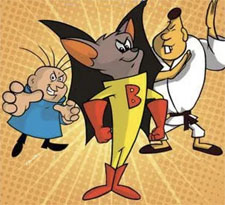 Batfink and Karate exit the batcave in their modified pink Volkswagen “Batillac”. Batfink figures the crooks will be trying to leave town, so Karate positions the Batillac as a barrier across the path of an exit road across a river bridge. The circus wagon approaches, but refuses to stop, approaching at full speed. Batfink has to pop out the car’s roof hatch and fly into the air, carrying the car upwards to avoid being crushed by the truck. The pursuit leads to a circus grounds, where our heroes find the wagon but not the crooks. Instead, the crooks find them. First, Karate is lifted into the air by the acrobat, who is hanging by his feet from a trapeze. Batfink attempts to fly upwards to save Karate, but is pulled back to earth by the other’s brother’s ringmaster whip, the end of which winds around Batfink’s feet. Batfink is not hurt, landing on his steel wings. However, something else has landed on his wings – the rear feet of an elephant, who holds Batfink pinned to the ground. Meanwhile, the acrobat brother now holds Karate suspended just inches above the jaws of a man-eating lion, who lashes out with his paws in attempt to get hold of Karate’s feet. The ringmaster brother announces that in exactly ten seconds, Karate will be dropped to the lion, and the elephant will sit upon Batfink, rendering him a “flat bat”. As the countdown ensues, Batfink emits his “supersonic sonar radar” – a visible and audible set of white letters reading “BEEP” which float through the air, usually in search of criminals. This time, however, the letters morph to combine into the shape of a white arrow, whose point jabs the elephant in the rear end. Instead of sitting, the elephant is startled forward, releasing Batfink from the ground. The elephant’s trunk also flies forward in a trumpet blast, slapping the ringmaster brother, and knocking him cold. Batfink zooms into the air to catch Karate before the lion can gobble him, then the two of them fly up to the acrobat brother, where Karate delivers a chop to the brother’s midriff, knocking him off the trapeze, and into a heap with his brother. With the two villains tied to a pole carried by Karate, Batfink and Karate return to police headquarters, delivering the rings pilfered by the villains to the chief. Karate remarks that it’s a good thing they made the capture, because otherwise, the villains would have had a “three-ring” circus.”
Batfink and Karate exit the batcave in their modified pink Volkswagen “Batillac”. Batfink figures the crooks will be trying to leave town, so Karate positions the Batillac as a barrier across the path of an exit road across a river bridge. The circus wagon approaches, but refuses to stop, approaching at full speed. Batfink has to pop out the car’s roof hatch and fly into the air, carrying the car upwards to avoid being crushed by the truck. The pursuit leads to a circus grounds, where our heroes find the wagon but not the crooks. Instead, the crooks find them. First, Karate is lifted into the air by the acrobat, who is hanging by his feet from a trapeze. Batfink attempts to fly upwards to save Karate, but is pulled back to earth by the other’s brother’s ringmaster whip, the end of which winds around Batfink’s feet. Batfink is not hurt, landing on his steel wings. However, something else has landed on his wings – the rear feet of an elephant, who holds Batfink pinned to the ground. Meanwhile, the acrobat brother now holds Karate suspended just inches above the jaws of a man-eating lion, who lashes out with his paws in attempt to get hold of Karate’s feet. The ringmaster brother announces that in exactly ten seconds, Karate will be dropped to the lion, and the elephant will sit upon Batfink, rendering him a “flat bat”. As the countdown ensues, Batfink emits his “supersonic sonar radar” – a visible and audible set of white letters reading “BEEP” which float through the air, usually in search of criminals. This time, however, the letters morph to combine into the shape of a white arrow, whose point jabs the elephant in the rear end. Instead of sitting, the elephant is startled forward, releasing Batfink from the ground. The elephant’s trunk also flies forward in a trumpet blast, slapping the ringmaster brother, and knocking him cold. Batfink zooms into the air to catch Karate before the lion can gobble him, then the two of them fly up to the acrobat brother, where Karate delivers a chop to the brother’s midriff, knocking him off the trapeze, and into a heap with his brother. With the two villains tied to a pole carried by Karate, Batfink and Karate return to police headquarters, delivering the rings pilfered by the villains to the chief. Karate remarks that it’s a good thing they made the capture, because otherwise, the villains would have had a “three-ring” circus.”
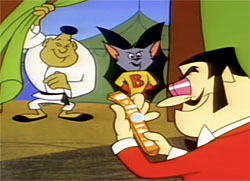 Jumping Jewelry (3/30/67) – Much as in one of Snooper and Blabber’s many encounters with fleas, a jewelry store is being robbed of its valuables, with its jewelry items seemingly hopping out of the safe under their own power. In reality, the culprits are a pack of trained fleas from a local flea circus. During investigation at the crime scene, the Chief starts itching. Batfink catches on that it may be a flea. The Chief slaps at te insect, but Karate, seeing the seemingly invisible dot on the ground, observes that the Chief only stunned him. Karate prepares to deliver a lethal chop to finish the insect off, but Batfink stops him, saving the flea’s life. Why? The flea may know something, and Batfink lets him escape through the mail slot, intending to follow him to whoever the ringleader is. The flea arrives late to the flea circus, as the human owner (Professor Hopper) counts up the stolen jewels. In sped-up sound effects that sound like Jack Benny’s violin exercises, the flea communicates the afternoon’s incident to his boss. Hopper asks if the flea was followed, but the flea insists he lost the Batillac in crosstown traffic. Sure enough, Karate has no idea where to drive. No problem. The supersonic sonar radar quickly spots the flea circus grounds, and reports back to Batfink. Our heroes pull back the tent flap to surprise Hopper, attempting to make an arrest. Hopper sics his fleas upon them. Batfink thinks his steel wings will shield him as usual – but the fleas merely hop under the wings, and soon have the boys scratching like crazy. Batfink spies the water of a high-diving tank, and our heroes race to dip into the soothing fluid. They never make it, as more of the fleas take hold of and extend a strand of rope across their path, tripping them and knocking Batfink and Karate out. When our heroes awaken, they are tied to the bulls-eye of a knife-thrower’s target. Hopper aims a circus cannon to fire a cannonball at them from point-blank range. The ball is fired, but at the last split-second, the board propping up the target to which our heroes are tied is knocked loose, allowing the target to fall backwards to the ground, and the cannonball to sail harmlessly overhead. Batfink and Karate are soon free, and capture Hopper. Hopper asks who knocked over the target, and Batfink shows him in the palm of one hand – the same flea whom Batfink had saved, who returned the favor by saving Batfink’s life Karate quotes the old adage – “A flea never forgets,”
Jumping Jewelry (3/30/67) – Much as in one of Snooper and Blabber’s many encounters with fleas, a jewelry store is being robbed of its valuables, with its jewelry items seemingly hopping out of the safe under their own power. In reality, the culprits are a pack of trained fleas from a local flea circus. During investigation at the crime scene, the Chief starts itching. Batfink catches on that it may be a flea. The Chief slaps at te insect, but Karate, seeing the seemingly invisible dot on the ground, observes that the Chief only stunned him. Karate prepares to deliver a lethal chop to finish the insect off, but Batfink stops him, saving the flea’s life. Why? The flea may know something, and Batfink lets him escape through the mail slot, intending to follow him to whoever the ringleader is. The flea arrives late to the flea circus, as the human owner (Professor Hopper) counts up the stolen jewels. In sped-up sound effects that sound like Jack Benny’s violin exercises, the flea communicates the afternoon’s incident to his boss. Hopper asks if the flea was followed, but the flea insists he lost the Batillac in crosstown traffic. Sure enough, Karate has no idea where to drive. No problem. The supersonic sonar radar quickly spots the flea circus grounds, and reports back to Batfink. Our heroes pull back the tent flap to surprise Hopper, attempting to make an arrest. Hopper sics his fleas upon them. Batfink thinks his steel wings will shield him as usual – but the fleas merely hop under the wings, and soon have the boys scratching like crazy. Batfink spies the water of a high-diving tank, and our heroes race to dip into the soothing fluid. They never make it, as more of the fleas take hold of and extend a strand of rope across their path, tripping them and knocking Batfink and Karate out. When our heroes awaken, they are tied to the bulls-eye of a knife-thrower’s target. Hopper aims a circus cannon to fire a cannonball at them from point-blank range. The ball is fired, but at the last split-second, the board propping up the target to which our heroes are tied is knocked loose, allowing the target to fall backwards to the ground, and the cannonball to sail harmlessly overhead. Batfink and Karate are soon free, and capture Hopper. Hopper asks who knocked over the target, and Batfink shows him in the palm of one hand – the same flea whom Batfink had saved, who returned the favor by saving Batfink’s life Karate quotes the old adage – “A flea never forgets,”
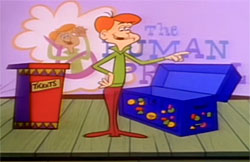 The Human Pretzel (4/24/67) receives honorable mention – one of those cartoons that can’t decide if it’s dealing with a circus or a carnival. A sideshow contortionist by the title name hides out in a shipping box aboard a mail plane, getting loaded onto the same flight with a shipment of priceless diamonds. He has room enough in the box for a parachute also, and exits the plane in flight with the loot. Batfink and Karate are called in. Batfink emits his usual sonar radar. The Beep quickly locates a closed carnival, where the Pretzel packs a large trunk, intending to mail himself to South America. The radar mingles with the items the villain tosses into the trunk, then the villain takes inventory of the contents: “Socks, shirts, shoes, Beep….BEEP?” The Pretzel gives away his identity, by tying the letters of the Beep into a pretzel knot to show Batfunk what he will get if he interferes. Our hero arrives at the carnival, referring to it as a “carnival of crime.” He searches the sideshow area, spotting the trunk on the platform designated for Pretzel’s act. Batfink knocks on it, demanding the Pretzel come out. Instead, the Pretzel emerges from a box on the Knife Thrower’s platform, and begins throwing knives at our hero. Batfink’s “shield of steel” wings render the attempt harmless. The Pretzel throws one knife at a rope, attached to a pulley on a pole above, on the end of which s tied a heavy anvil. The anvil drops toward Batfink, but his wings again do the trick, catching the anvil on their upper tips, allowing Batfink to merely tilt to dump the anvil out of the way. “You think you’re pretty smart – Well, I think you’re a dumbbell”, says the Pretzel, hurling an iron barbell at Batfink from the strong man’s platform. Barfink merely ducks, again appearing to have outmaneuvered the villain. But this time, the barbell hits a rope tethered between the ground and a circus tent, which stretches to toss the barbell back at our hero. Batfink is finally hit from the back, and hurtles into a baseball-pitch booth. For once, no “dodger” head-hole is involved here. Instead, a wooden stand-up figure of a devil, with his nose serving as a target, is standing in the center of the booth, and Batfink crashes into the back of the wooden object face first, knocking himself cold behind the figure. Karate appears at the booth, just as the Pretzel also enters with intent to find an evil way to dispose of the meddling superhero. “Have you seen a bat?” asks Karate. “No bats, but how ‘bout some balls?” responds the Pretzel. The Pretzel offers Karate a free chance to win a teddy bear, if he can hit the devil target three times. Karate boasts that he never misses, and uses his karate chops to sock two baseballs directly on target to the devil’s nose. For the final shot, the Pretzel substitutes a lit black bomb for a baseball, intending to allow Karate to do his partner in. Karate chops again, but proves fallible, this time only scoring a near miss, with the bomb’s explosion rousing Batfink to his senses. The Pretzel sees, and zips away for a hasty exit. Batfink takes up an armful of balls, and scores three consecutive hits upon the back of the fleeing Pretzel’s head, knocking him out. Karate hands Batfink a teddy bear for getting three out of three, but Batfink hands the bear to Karate instead. “You deserve it, for only getting two out of three.’
The Human Pretzel (4/24/67) receives honorable mention – one of those cartoons that can’t decide if it’s dealing with a circus or a carnival. A sideshow contortionist by the title name hides out in a shipping box aboard a mail plane, getting loaded onto the same flight with a shipment of priceless diamonds. He has room enough in the box for a parachute also, and exits the plane in flight with the loot. Batfink and Karate are called in. Batfink emits his usual sonar radar. The Beep quickly locates a closed carnival, where the Pretzel packs a large trunk, intending to mail himself to South America. The radar mingles with the items the villain tosses into the trunk, then the villain takes inventory of the contents: “Socks, shirts, shoes, Beep….BEEP?” The Pretzel gives away his identity, by tying the letters of the Beep into a pretzel knot to show Batfunk what he will get if he interferes. Our hero arrives at the carnival, referring to it as a “carnival of crime.” He searches the sideshow area, spotting the trunk on the platform designated for Pretzel’s act. Batfink knocks on it, demanding the Pretzel come out. Instead, the Pretzel emerges from a box on the Knife Thrower’s platform, and begins throwing knives at our hero. Batfink’s “shield of steel” wings render the attempt harmless. The Pretzel throws one knife at a rope, attached to a pulley on a pole above, on the end of which s tied a heavy anvil. The anvil drops toward Batfink, but his wings again do the trick, catching the anvil on their upper tips, allowing Batfink to merely tilt to dump the anvil out of the way. “You think you’re pretty smart – Well, I think you’re a dumbbell”, says the Pretzel, hurling an iron barbell at Batfink from the strong man’s platform. Barfink merely ducks, again appearing to have outmaneuvered the villain. But this time, the barbell hits a rope tethered between the ground and a circus tent, which stretches to toss the barbell back at our hero. Batfink is finally hit from the back, and hurtles into a baseball-pitch booth. For once, no “dodger” head-hole is involved here. Instead, a wooden stand-up figure of a devil, with his nose serving as a target, is standing in the center of the booth, and Batfink crashes into the back of the wooden object face first, knocking himself cold behind the figure. Karate appears at the booth, just as the Pretzel also enters with intent to find an evil way to dispose of the meddling superhero. “Have you seen a bat?” asks Karate. “No bats, but how ‘bout some balls?” responds the Pretzel. The Pretzel offers Karate a free chance to win a teddy bear, if he can hit the devil target three times. Karate boasts that he never misses, and uses his karate chops to sock two baseballs directly on target to the devil’s nose. For the final shot, the Pretzel substitutes a lit black bomb for a baseball, intending to allow Karate to do his partner in. Karate chops again, but proves fallible, this time only scoring a near miss, with the bomb’s explosion rousing Batfink to his senses. The Pretzel sees, and zips away for a hasty exit. Batfink takes up an armful of balls, and scores three consecutive hits upon the back of the fleeing Pretzel’s head, knocking him out. Karate hands Batfink a teddy bear for getting three out of three, but Batfink hands the bear to Karate instead. “You deserve it, for only getting two out of three.’
Next Time: a few stragglers, then moving on into TV’s later years.


 Charles Gardner is an animation enthusiast who toils by day as a member of LA Law – but by nights and weekends indulges in classic jazz and ragtime as a performer; and studies classic Hollywood cartoons… maybe a little too much.
Charles Gardner is an animation enthusiast who toils by day as a member of LA Law – but by nights and weekends indulges in classic jazz and ragtime as a performer; and studies classic Hollywood cartoons… maybe a little too much.


































































































































































I remember watching “Astro Boy” as a preschooler, but the only thing I remember about it is that I didn’t like it. The show came back later on in my childhood — probably the only black-and-white cartoon to do so — and by that time I was better able to appreciate it. The very first episode blew my mind, or freaked me out, to use a couple of then-current idioms, and your description of it brings back a lot of memories. I remember the scientist scolding Astro Boy for being unable to grow, and the eager-to-please young robot trying to oblige by extending his neck mechanically like a telescope, which only exasperated the scientist further. The disturbing themes and compelling drama often shone through despite Fred Ladd’s playing fast and loose with the source material.
The owner of the robot circus only has an Italian accent in the English language dub. In the original he’s known as Ham Egg, a recurring villain in many of Tezuka’s manga and anime series. Tezuka modeled him partly on Peter Lorre and partly on the villain in Milt Gross’s “He Done Her Wrong”. Ham Egg played a conniving circus ringmaster on more than one occasion.
It’s interesting that the advertisement for Rock Bottom’s erstwhile circus act was clipped out of a newspaper from Bridgeport, Connecticut, as P. T. Barnum lived in that city for most of his life and even served a term as its mayor. Barnum’s star performer General Tom Thumb — who, like Astro Boy, stopped growing early in life — was also a Bridgeport native.
A more relevant Bridgeport connection: Jim Tyer, who was an animator on “Felix’s Gold Mine”, was born in Bridgeport and, after his stint at Fleischer in Miami in the early ‘40s, returned there to live for the rest of his life. As a native son, he would have been well aware of Barnum’s presence in that city. I have no idea what significance the date of August 7th 1949 might have.
Good old Joseph Oriolo and Hal Seeger: two former Fleischer animators who branched off on their own, taking Winston Sharples’ Famous Studios music tracks with them.
I remember that Speed Racer episode. When the clown is talking about spending all their money on feeding the animals, the visuals show an angry lion evidently turning on its trainer, the implication being the clown was a lion tamer who lost his mojo and fled as a result. Always watched for hints of something being sanitized in translation (“Those harmless tranquilizer bullets will keep him quiet, ha ha!”).
Fell into a reverie yesterday based on my delayed surprise in getting circus references from Japanese cartoons. Various international tours did take place, but I still wonder how much of the audience had been to a circus and how many had just seen it in imported movies and TV. Also, should there be more instances in European cartoons?
Then I spent some time in the popular game of trying to think of an obscure subject for an Animation Trail — either so obscure I can only come up with one example, or one obscure with surprisingly many uses. Yesterday it was blood donation and ice harvesting. For the first, I can only think of one educational film, but the second… surely every time a character falls in cold water and comes up in a rectangular block of ice is a reference to that! (Luckily for maintaining the humor, when home ice delivery was replaced by home refrigerators, it was still most convenient to make the ice in the shape of cubes.)
Blood Donation had a number of other uses. Popeye donates, and dreams he has lost a prize fight by taking on the champ too soon afterwards, in “Spinach Packin’ Popeye.” The bloodhounds of Simon Legree can’t pursue Uncle Tom because they are “busy” – rolling up their fur for donations in a blood bank – in Tex Avery’s “Uncle Tom’s Cabana” for MGM. And let’s not forget the transfusions with unusual cross-results in both Avery’s “Crazy Mixed-Up Pup” for Lantz, and in Paramount’s “Chew Chew Baby”. (There’s also a sawdust transfusion in Disney’s “Broken Toys”, and in Columbia’s “Imagination”). There’s probably more in some of the newsreel cartoons of the late ’30’s or 1940’s. Either “The Film Fan” or “Porky’s Snooze Reel” also includes a microscopic view of the human blood stream – with blood cells taking leisurely swims and yachting.
Bloodhounds, ha! I guess I didn’t do too good that round. My mind first came up with a ’40s comicbook where the Human Torch had to give a “flame transfusion” to Toro, the Torchy Boy that I’d read reference to or excepts from in the ’70s. That’s not what I was looking for on many levels, but I foundered on those shores and couldn’t get anywhere else.
An interesting continuity error in Speed Racer’s “Girl Daredevil” just dawned on me, either indicating the animators’ lack of knowledge of international geography, pr possibly another instance where something was lost in translation. The radio weather bulletin preceding the car tightrope stunt at Niagara Falls states that the winds will have increased force on the Canadian side. However, the stunt is performed traveling from right to left across the face of the falls – indicating that she actually begins her drive on the Canadian side, driving toward the American side. This would place the point in the stunt where the winds picked up on the opposite side of the falls than indicated in the weather report! Who blew this little detail?